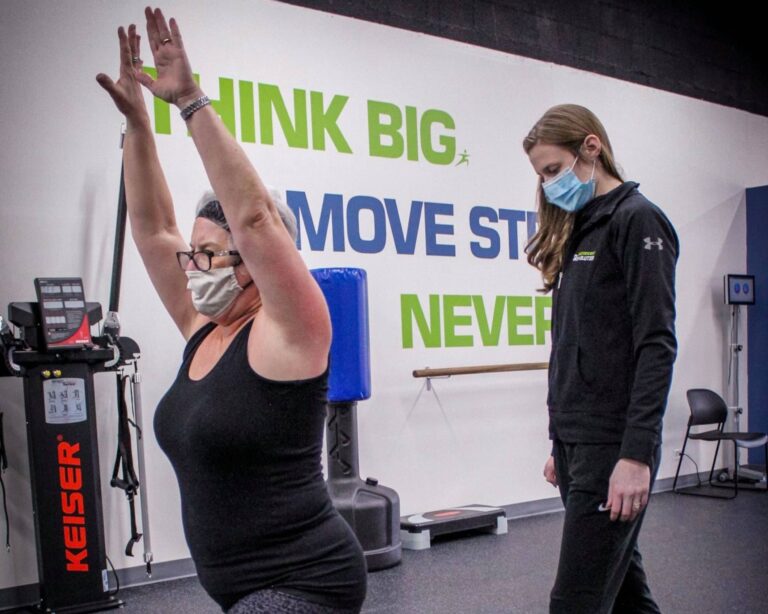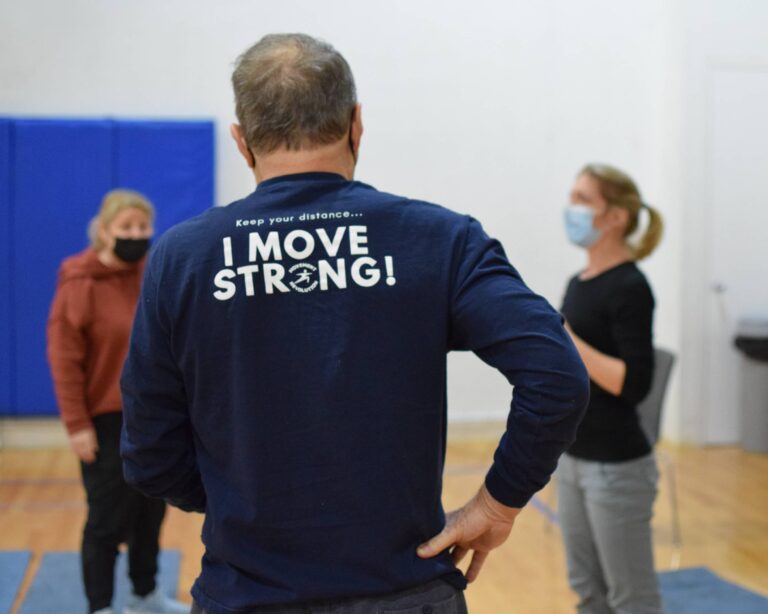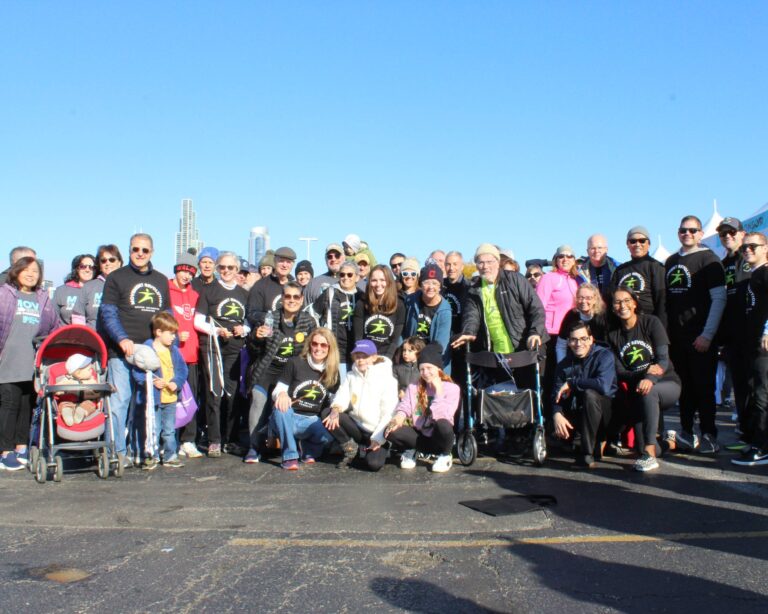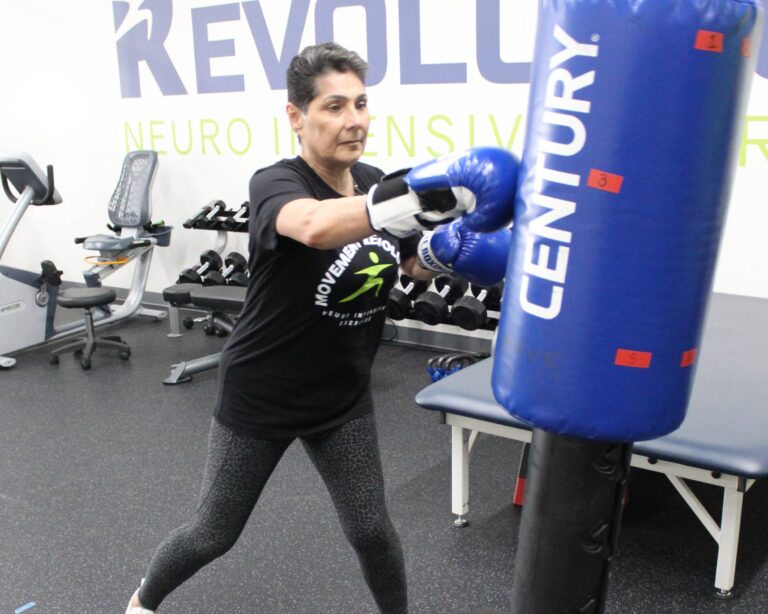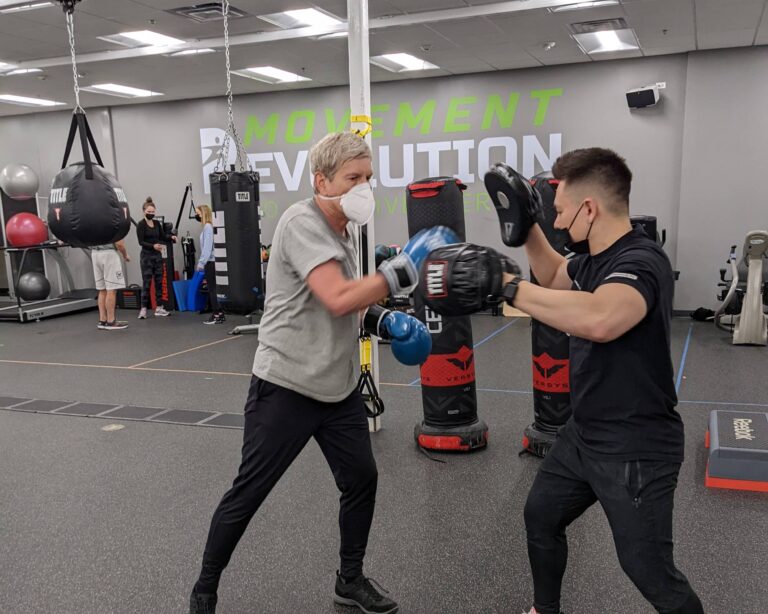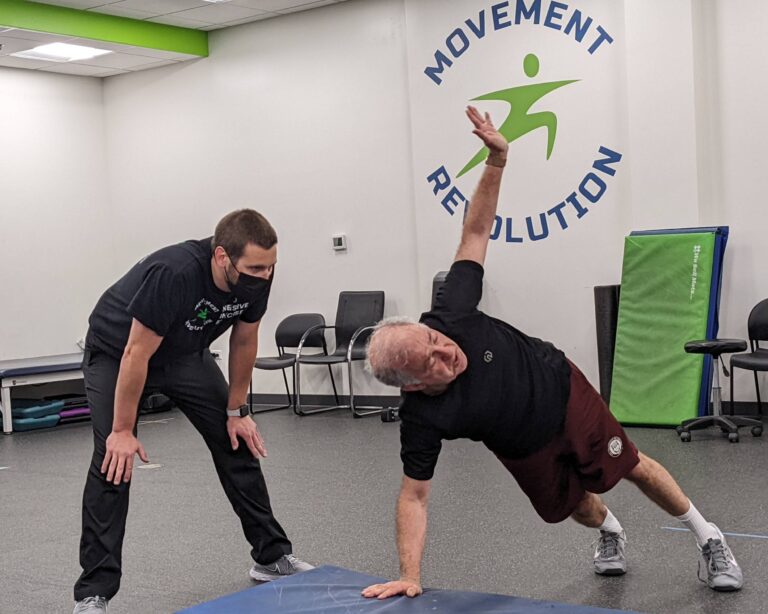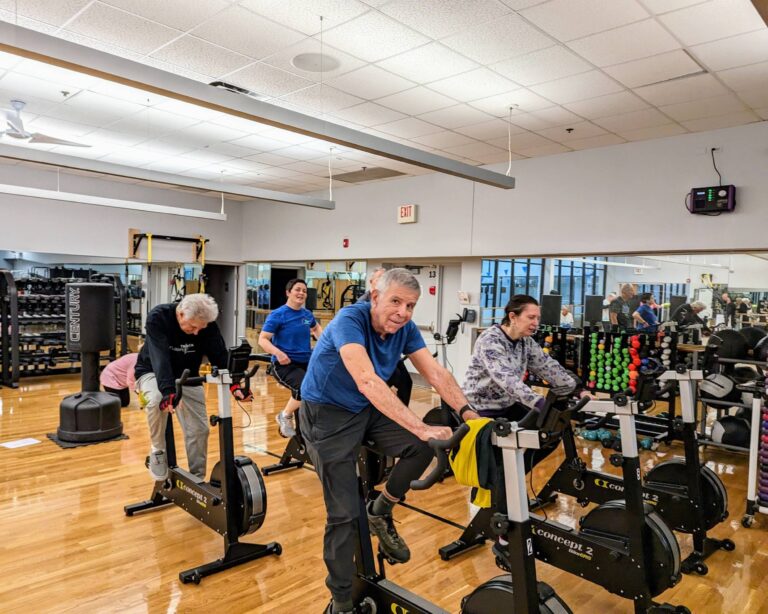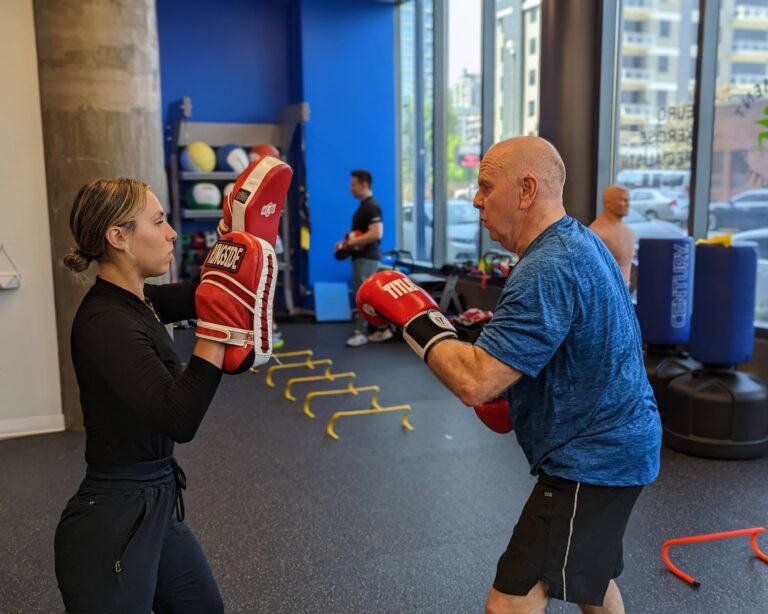Our Neuro Exercise Specialists understand the specific motor and non-motor symptoms associated with Parkinson’s disease and how exercise can help manage them. We are also experts in the use of specific exercises, such as high-intensity interval training and boxing, which have been shown to be effective in improving movement and function. We stay up to date on the latest research and developments in the field of exercise and Parkinson’s disease, which allows us to provide the most current and effective exercise programs for our clients. This also helps us ensure our programs pick up where therapy leaves off.
Parkinson’s Disease Exercise Program Highlights
- Expert, trained staff for all ability levels
- Specialized equipment including a body weight support track system that enables our clients to practice walking without the risk of falling
- A variety of exercise services and programs including:
- Personalized One-on-One Programs
- Group Exercise Classes
- Rock Steady Boxing Chicago Programs
“I can do things physically I couldn’t do before Parkinson’s. This is probably the healthiest I’ve been in my adult life.”
—Kathy McCarthy, Parkinson’s
Did you know …
Exercise has also been shown to increase the production of brain-derived neurotrophic factor (BDNF), a protein that promotes the growth and survival of neurons in the brain. This is important because the loss of dopamine-producing neurons in the brain is a hallmark of Parkinson’s disease.
What to Expect from Our Parkinson’s Exercises
At Movement Revolution, our Neuro Exercise Specialists work with you to develop a personalized treatment plan based on your specific needs, abilities and limitations. Some common goals for individuals with Parkinson’s disease that Movement Revolution may help you work on include:
Improving motor symptoms: Parkinson’s disease can cause various motor symptoms, such as tremors, stiffness and slowness of movement.
Improving balance and coordination: Parkinson’s disease can affect your balance and coordination, increasing your risk of falls.
Improving strength and flexibility: Parkinson’s disease can lead to weakness and reduced flexibility, making it difficult to perform daily activities.
Improving cardiovascular health: Exercise can help improve cardiovascular health, which is important for overall health and well-being.
Improving mood and quality of life: Parkinson’s disease can be challenging and impact your mood and overall quality of life.
The specific goals and treatment plan you will work on will depend on your unique situation and the goals you want to achieve.
“The entire team is so welcoming. They have this spirit about them—it’s not a job; it’s a calling. They know what to do, how to support you, how to make you not afraid. They make you feel like, ‘I can do this.’ ”
—Julia Luft, Parkinson’s
“The trainers here are experts in their fields and far exceed anything I’ve experienced in the past. I look forward to every session.”
—Neil Richter, Parkinson’s
Frequently Asked Questions
There is no one “best” exercise for Parkinson’s disease, as the most effective exercise program will depend on each individual’s specific needs and abilities. The best exercise for someone with Parkinson’s disease may include a combination of aerobic exercise, strength training and balance exercises.
- Aerobic exercise: Aerobic exercises, such as walking, cycling or swimming, can help improve cardiovascular health, reduce stiffness and improve overall mood.
- Strength training: Strength training, using weights or resistance bands, can help improve muscle strength, flexibility and balance.
- Balance training: Balance exercises, such as standing on one leg or walking heel-to-toe, can help improve balance and reduce the risk of falls.
- Flexibility training: Stretching and flexibility exercises, such as yoga or Tai Chi, can help improve the range of motion and reduce stiffness.
- Dual-task training: Dual-task training involves combining physical exercise with cognitive tasks and can help improve cognitive function and reduce the risk of falls.
To find the right exercise for you, it is important to work with a healthcare professional, such as a physical therapist or a Neuro Exercise Specialist, who can design an exercise program that is safe and effective for your specific needs and abilities.
It’s completely normal to feel nervous about starting to exercise, especially if you have Parkinson’s disease. However, there are many ways to make exercise more approachable and manageable, even if you have limited mobility or experience with exercise.
One of the most important things to remember is that starting small and progressing gradually is key to success. It’s okay to start with very simple exercises, such as walking or gentle stretching and gradually increase the intensity or duration of the exercise as you become more comfortable and confident.
It’s understandable to be nervous about the cost of a personal trainer or exercise program. However, many resources are available to help make exercise more affordable and accessible. You may want to check with your insurance provider to see if they cover any portion of the cost of a personal trainer or exercise program. Some insurance plans may cover these costs as part of a wellness or disease management program. Investing in your health and well-being through exercise can ultimately reduce healthcare costs and improve quality of life.
It’s important to work with a healthcare professional, such as a physical therapist or a Neuro Exercise Specialist, to design an exercise program that is safe and effective for your specific needs and abilities. The healthcare professional can provide guidance on proper form and technique to help prevent injury and can help modify the exercise program as needed. Additionally, it’s important to listen to your body and stop if you experience any pain or discomfort. Starting with simple exercises and progressing gradually can also help prevent injury and avoid exacerbating symptoms.
The intensity of exercise should be appropriate for your fitness level and physical abilities. It is important to challenge yourself, but not to the point of exhaustion or pain. Consult with a Neuro Exercise Specialist to discuss the appropriate intensity for you.
Depending on your individual needs, you may be able to do exercises on your own or with the guidance of a healthcare professional. However, working with a Neuro Exercise Specialist can help ensure that you are performing exercises safely and effectively. Some people with Parkinson’s disease may find it helpful to participate in group exercise classes or to exercise with a partner for motivation and support. This can also be a great way to meet others with Parkinson’s disease and build a sense of community.
Yes, there is evidence to suggest that regular exercise can help slow down the progression of Parkinson’s disease. Studies have shown that exercise can improve motor symptoms such as tremors, rigidity and bradykinesia (slowness of movement), as well as non-motor symptoms such as depression, anxiety and sleep disturbances.
No, exercise cannot replace medication prescribed by a healthcare professional for treating Parkinson’s disease. Medications are used to manage the symptoms of Parkinson’s disease by replacing the dopamine lost in the brain, while exercise is used to improve overall health and well-being and may help slow the progression of the disease.
However, regular exercise may help improve the effectiveness of medication and overall health and well-being, ultimately leading to reduced healthcare costs and improved quality of life. It’s important to work with your healthcare professional to develop a comprehensive treatment plan that includes medication, exercise and other therapies as needed.
Movement Revolution can provide a comprehensive, multidisciplinary approach to the management of Parkinson’s disease, with a focus on improving function, reducing symptoms and enhancing the quality of life. Here are some ways we can help:
- Multidisciplinary approach: Movement Revolution has Neuro Exercise Specialists with specialized training in neurorehabilitation. Our team works together to develop a customized treatment plan that addresses your specific needs and goals. Our staff often works closely with other healthcare providers, such as physical therapists, occupational therapists and physicians, to ensure a coordinated and comprehensive approach to care. Our team communicates with other providers about progress and adjusts the exercise program as needed to support overall treatment goals.
- Evidence-based treatments: Movement Revolution offers evidence-based treatments and interventions that have been shown to be effective in improving symptoms of Parkinson’s disease, such as exercise therapy, gait training and cognitive rehabilitation.
- Support and education: Parkinson’s disease can be challenging to manage; at Movement Revolution, we can offer support and education for both patients and caregivers. This may include education on Parkinson’s disease and its management, as well as emotional support and resources for coping with the challenges of living with the condition.
- Community and social support: Movement Revolution often provides opportunities for patients to connect with others living with Parkinson’s disease through support groups, peer mentoring and social activities. This can help reduce feelings of isolation and provide a sense of community and support.
Your Roadmap to Living Stronger
When you become a part of Movement Revolution, you begin with a comprehensive movement evaluation utilizing the latest tools and technology. Each assessment is unique to your diagnosis and is used to establish your personal goals, objectives, and desired physical outcomes.
Want to connect with us, or request an assessment? Complete the form below, and a member of our team will be in touch shortly!


